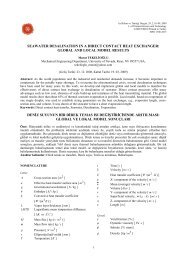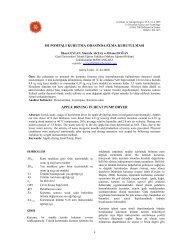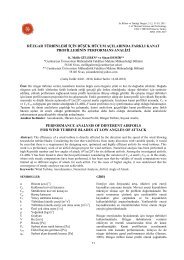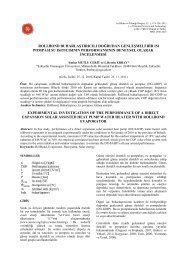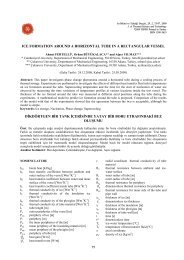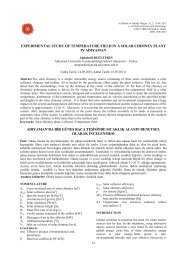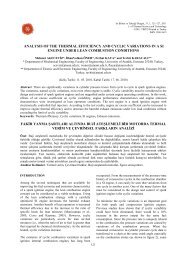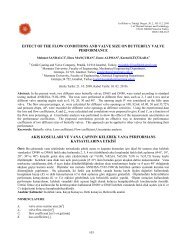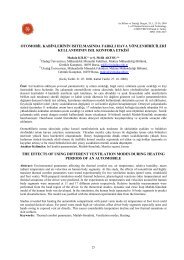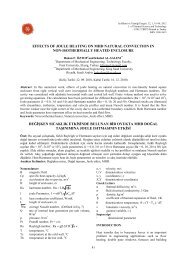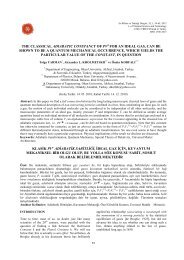modelling of an automotive air conditioning system using anfis
modelling of an automotive air conditioning system using anfis
modelling of an automotive air conditioning system using anfis
Create successful ePaper yourself
Turn your PDF publications into a flip-book with our unique Google optimized e-Paper software.
<strong>system</strong> (ANFIS) with signific<strong>an</strong>tly less engineering<br />
effort. The main feature <strong>of</strong> these new techniques is the<br />
ability <strong>of</strong> self learning <strong>an</strong>d self-predicting some desired<br />
outputs. These techniques c<strong>an</strong> extract expertise from<br />
data without requiring <strong>an</strong>y explicit mathematical<br />
representation, thus easily <strong>modelling</strong> the physical<br />
phenomena in complex <strong>system</strong>s to predict their<br />
behaviour under given conditions. Therefore, they c<strong>an</strong><br />
be applied to various engineering problems which are<br />
too complex to deal with <strong>using</strong> classical <strong>modelling</strong><br />
techniques.<br />
ANFIS, the less-known approach compared with ANN,<br />
is a s<strong>of</strong>t computing technique that combines the benefits<br />
<strong>of</strong> feed forward calculation <strong>of</strong> output <strong>an</strong>d back<br />
propagation <strong>of</strong> learning capability <strong>of</strong> ANNs <strong>an</strong>d hum<strong>an</strong>like<br />
reasoning style <strong>of</strong> fuzzy logic. Therefore, ANFIS<br />
based models are very powerful universal approximators<br />
with the ability <strong>of</strong> interpretable IF-THEN rules, <strong>an</strong>d they<br />
are applied in m<strong>an</strong>y fields such as <strong>system</strong> identification,<br />
fuzzy control, data processing, etc.<br />
The ANN <strong>modelling</strong> <strong>of</strong> <strong>air</strong> <strong>conditioning</strong> <strong>an</strong>d<br />
refrigeration <strong>system</strong>s has been studied by m<strong>an</strong>y<br />
investigators. However, the application <strong>of</strong> ANFIS<br />
approach to the <strong>modelling</strong> <strong>of</strong> thermal <strong>system</strong>s is a more<br />
recent progress, although ANFIS was first introduced in<br />
early 90s (J<strong>an</strong>g, 1993). Hasiloglu et al. (2004)<br />
performed ANFIS <strong>modelling</strong> <strong>of</strong> the tr<strong>an</strong>sient heat<br />
tr<strong>an</strong>sfer in circular duct flow. Esen et al. (2007)<br />
predicted the perform<strong>an</strong>ce <strong>of</strong> a ground-coupled heat<br />
pump <strong>system</strong> <strong>using</strong> ANFIS. They also compared the<br />
ANFIS predictions with the ANN ones for the groundcoupled<br />
heat pump <strong>system</strong> (Esen et al., 2008). Ertunc<br />
<strong>an</strong>d Hosoz (2008) developed ANFIS <strong>an</strong>d ANN models<br />
for predicting the perform<strong>an</strong>ce <strong>of</strong> <strong>an</strong> evaporative<br />
condenser. They found that the accuracies <strong>of</strong> ANFIS<br />
predictions were slightly better th<strong>an</strong> those <strong>of</strong> ANN ones.<br />
Soyguder <strong>an</strong>d Alli (2009) predicted the f<strong>an</strong> speed for<br />
energy saving in <strong>an</strong> HVAC <strong>system</strong> <strong>using</strong> ANFIS. Das<br />
<strong>an</strong>d Kishor (2009) developed <strong>an</strong> ANFIS model for<br />
predicting the heat tr<strong>an</strong>sfer coefficient in pool boiling <strong>of</strong><br />
distilled water. Ata <strong>an</strong>d Kocyigit (2010) used ANFIS to<br />
predict the tip speed ratio in wind turbines. Hosoz et al.<br />
(2011) investigated the applicability <strong>of</strong> ANFIS to<br />
predict the perform<strong>an</strong>ce <strong>of</strong> <strong>an</strong> R134a vapor-compression<br />
refrigeration <strong>system</strong> <strong>using</strong> a cooling tower for heat<br />
rejection. They found that the ANFIS approach c<strong>an</strong> be<br />
used successfully for predicting the perform<strong>an</strong>ce <strong>of</strong><br />
refrigeration <strong>system</strong>s.<br />
As c<strong>an</strong> be seen from the literature survey outlined<br />
above, the perform<strong>an</strong>ce <strong>of</strong> AAC <strong>system</strong>s has not been<br />
modelled yet <strong>using</strong> ANFIS approach. However, previous<br />
studies report that the predictions <strong>of</strong> ANFIS approach<br />
are usually slightly better th<strong>an</strong> those <strong>of</strong> ANN, the other<br />
alternative artificial intelligence technique, for<br />
refrigeration <strong>an</strong>d <strong>air</strong> <strong>conditioning</strong> <strong>system</strong>s (Ertunc <strong>an</strong>d<br />
Hosoz, 2008; Esen <strong>an</strong>d Inalli, 2010). Therefore, this<br />
study investigates the applicability <strong>an</strong>d reliability <strong>of</strong><br />
ANFIS <strong>modelling</strong> to predict various perform<strong>an</strong>ce<br />
parameters <strong>of</strong> <strong>an</strong> AAC <strong>system</strong>. For this aim, <strong>an</strong><br />
experimental R134a AAC <strong>system</strong> with a variable<br />
capacity compressor has been set up <strong>an</strong>d tested under a<br />
broad r<strong>an</strong>ge <strong>of</strong> operating conditions. Then, <strong>using</strong><br />
experimental data, its perform<strong>an</strong>ce parameters have<br />
been evaluated, <strong>an</strong>d <strong>an</strong> ANFIS model for the prediction<br />
<strong>of</strong> the perform<strong>an</strong>ce parameters <strong>of</strong> the AAC <strong>system</strong> has<br />
been developed. Finally, the model results have been<br />
compared with experimental ones for determining the<br />
perform<strong>an</strong>ce <strong>of</strong> the ANFIS predictions.<br />
DESCRIPTION OF THE EXPERIMENTAL AAC<br />
SYSTEM AND TESTING PROCEDURE<br />
The ANFIS approach has been applied to the<br />
experimental AAC <strong>system</strong> shown in Figure 1. The<br />
experimental AAC <strong>system</strong> mainly consists <strong>of</strong> the<br />
original components from a compact size R134a<br />
automobile <strong>air</strong> <strong>conditioning</strong> <strong>system</strong>, namely a fivecylinder<br />
wobble-plate variable capacity compressor with<br />
a swept volume <strong>of</strong> 9.8–151 cc/rev, a parallel-flow<br />
micro-ch<strong>an</strong>nel condenser, a liquid receiver/filter/drier,<br />
<strong>an</strong> internally-equilized thermostatic exp<strong>an</strong>sion valve <strong>an</strong>d<br />
a laminated type evaporator. The experimental <strong>system</strong><br />
also has some auxiliary equipment, which is used for<br />
providing the required test conditions <strong>an</strong>d some<br />
instruments for mech<strong>an</strong>ical measurements.<br />
As seen in Figure 1, the evaporator <strong>an</strong>d condenser were<br />
inserted into two separate <strong>air</strong> ducts. The evaporator <strong>an</strong>d<br />
condenser <strong>air</strong> ducts have cross-section areas <strong>of</strong> 0.048 m 2<br />
<strong>an</strong>d 0.219 m 2 , respectively, while they have the same<br />
length <strong>of</strong> 1 m. In order to provide the required <strong>air</strong><br />
streams in these ducts, a centrifugal f<strong>an</strong> <strong>an</strong>d <strong>an</strong> axial f<strong>an</strong><br />
were placed at the entr<strong>an</strong>ces <strong>of</strong> the evaporator <strong>an</strong>d<br />
condenser ducts, respectively. Because these f<strong>an</strong>s are<br />
driven by DC motors, the <strong>air</strong> flow rates passing through<br />
the evaporator <strong>an</strong>d condenser c<strong>an</strong> be adjusted to the<br />
required values by varying the voltages across the f<strong>an</strong><br />
motors via voltage regulators. These ducts also contain<br />
electric heaters located upstream <strong>of</strong> the evaporator <strong>an</strong>d<br />
condenser. The evaporator <strong>an</strong>d condenser electric<br />
heaters c<strong>an</strong> be controlled between 0–1.8 kW <strong>an</strong>d 0–5.6<br />
kW, respectively, to provide the required <strong>air</strong><br />
temperatures at the inlets <strong>of</strong> the related coils. Both <strong>air</strong><br />
ducts were insulated with polyureth<strong>an</strong>e foam <strong>of</strong> 3 cm<br />
thick.<br />
The compressor was belt-driven by a three-phase 4 kW<br />
electric motor. In order to ensure that the compressor<br />
could be operated at <strong>an</strong>y required speed, the electric<br />
motor was energized through a frequency inverter.<br />
Because the employed compressor was a variable<br />
capacity one <strong>an</strong>d the experimental <strong>system</strong> was not<br />
equipped with a thermostat in order to test the <strong>system</strong> in<br />
steady-state operation without interruption, the<br />
compressor <strong>of</strong> the experimental AAC <strong>system</strong> operated<br />
continually until the end <strong>of</strong> the each test.<br />
129



